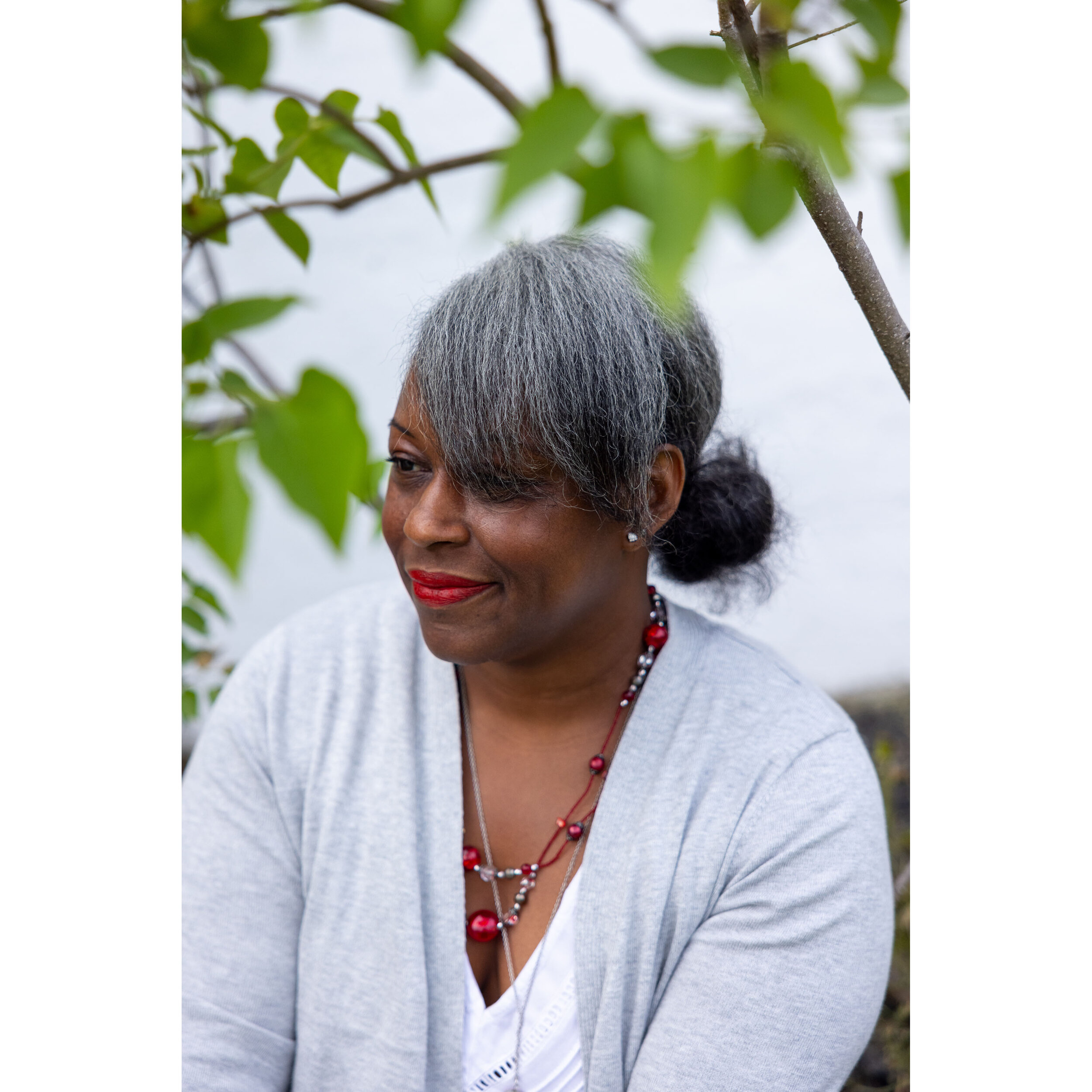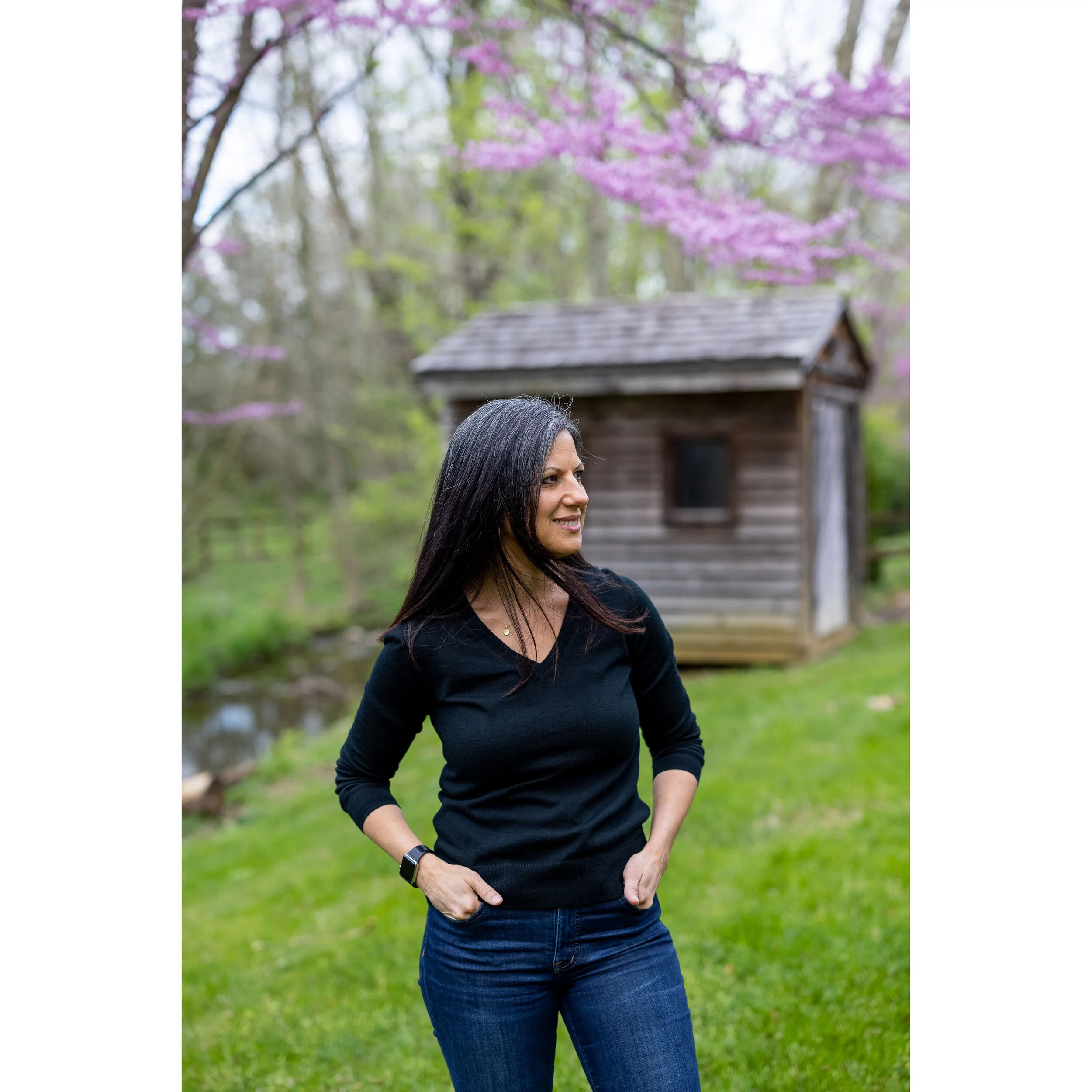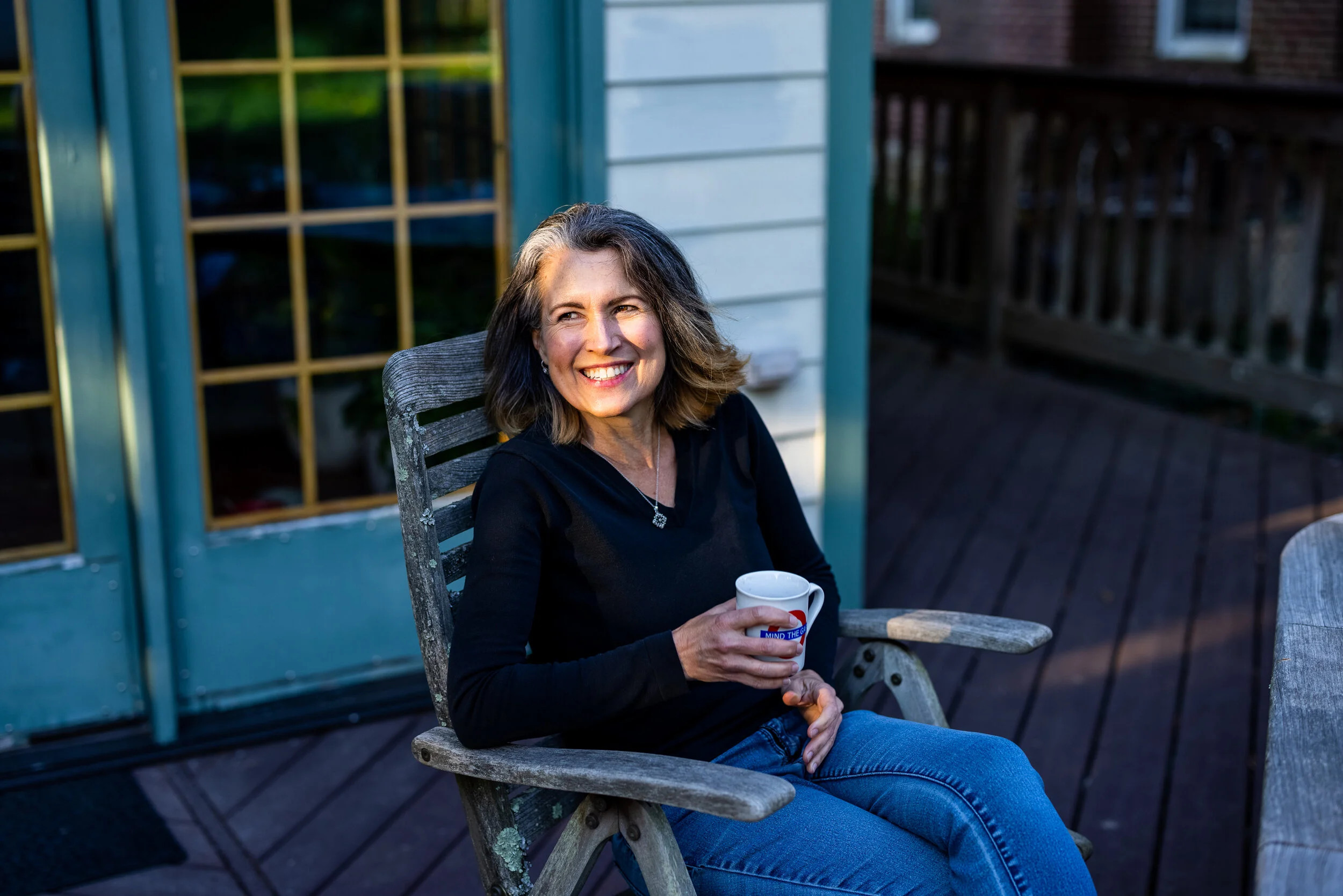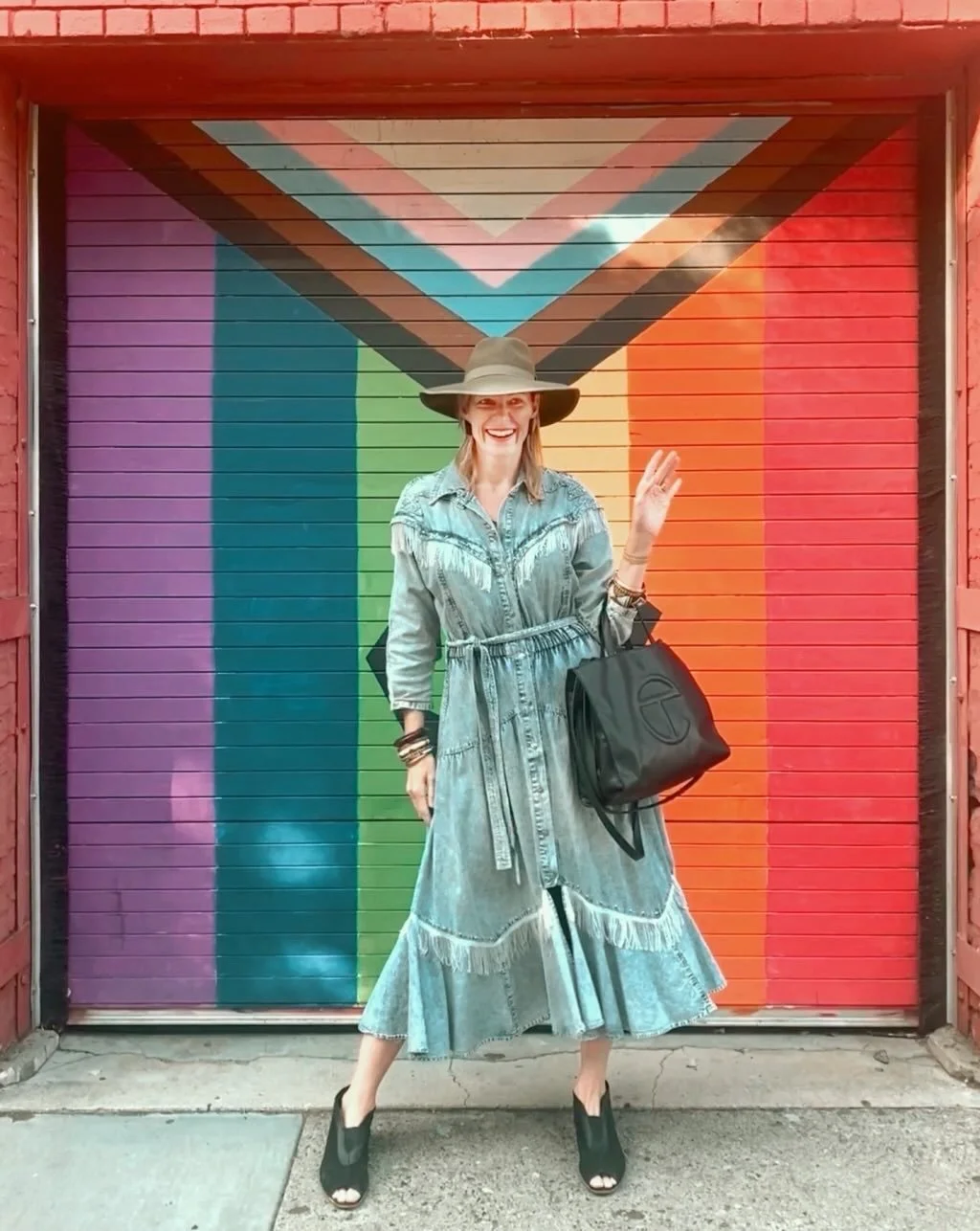Rise of the Silver Vixen
Photography by Dave Cooper
Text by Jennifer Cooper
“I feel more comfortable in my own skin now than I have before.”
Louise Fox was the first woman I ever knew who had a full head of white hair. She had gone gray in her youth and by the time she was pregnant with her ninth child, she looked like a grandmother.
Of course, she was a grandmother—my grandmother—so maybe I was biased.
My mom, Louise’s daughter, got her first gray in high school. As a kid, I looked through Mom’s thick, beautiful, raven-colored waves to find any rogue white strands. When I’d spot one, I’d ask, “Can I pluck it?” “Sure,” she’d say.
Meanwhile, Miss Clairol sang, I’m gonna wash that gray right out of my hair through the airwaves into our living room.
Me? I don’t know how old I was when I spotted my first gray. In fact, it wasn’t even me who spotted it. It was discovered by a mom at the playground who leaned in thinking it was a stripe of white paint. Instead, it was just some gray glittering in the sun. I could tell she was embarrassed for me.
Social scientists have long known that the images and messages we receive shape our thoughts and behavior. Hear a message repeated enough, and it becomes wedged so deeply in our subconscious that we no longer question it. It simply becomes a part of us.
It becomes internalized.
And when it comes to the messages women receive about their hair, well, that’s when we begin to think that the most natural things about us are something we need to hide.
Like aging.
Not only are we told centuries-old tales designed to reinforce ideas about women that disconnect us from our power—that our best years are our childbearing years, that we are supposed to be caregivers before anything else, that our sexuality is a source of shame—this idea that aging is bad is a money maker. There’s a whole 50 billion dollar a year industry whose sole purpose is to convince us to feel bad about ourselves.
The beauty industry is a powerful messaging machine.
But something happened during the pandemic. A social media movement that began a few years ago began to accelerate; its aim is to change perspectives on women choosing to age naturally.
Women were presented with images and new messaging that boldly stated: Silver hair is stunning. And today, we can see the impact of that messaging beyond the screen.
Sure, it took a worldwide shutdown that threw the power structures off their axes and caused the democratization of image sharing, but here we are.
Actually, are we here? Are we finally at a point where we can see women over 40 as whole, empowered, and vibrant?
We spoke with three different women—one in her 40s, one in her 50s, and one in her 60s—to see what we can learn about this movement to ditch the dye and embrace the freedom in going gray.
Brandee White, 45, started going gray as a teenager.
Ditching Convention
Ever since Madeline Comoglio was a little girl, she’s gotten compliments on her raven-colored hair. It was part of her look. It was also hard to maintain.
“I started going gray in my 20s. I have this memory of looking in the mirror and searching for gray hairs to pull out.” To keep up with the silvers, Madeline was dying her hair every two weeks. “I’d have a week of feeling great and then the second I’d see the gray line; I’d hate looking in the mirror.”
The gray consumed her thoughts. “Any special occasion or dinner out, I’d get a root touch up.” Madeline wasn’t alone. Since the 1950s, most American women have dyed their hair. In fact, some estimates put it over 80%.
It’s not normal to see gray hair because we’ve made it abnormal through advertising, television, movies, social pressure, and big corporations. The hair color market is estimated to hit $32 billion this year. While we’re washing that gray right out of our hair, the hair coloring industry is showering itself with our money.
One day, Madeline, who runs a stationery studio that specializes in weddings, stumbled across some grombre Instagram accounts (which celebrate going gray) and loved what she saw but felt she was too young to try it. “I thought it’d be an over-50 goal.”
Although she thought she wasn’t quite ready, she still mentioned it to her family. At first her daughter said she’d be embarrassed if her mom went gray, but Madeline’s husband had a different take. He said, “I think you would look awesome.” He also said it’d be women and friends who would judge her, and that would be the toughest part.
So Madeline took it to her friends. “Some of them said I could rock it, but most were like, ‘No, you’re too young for that.’ Even my sister, who is older and a hippie about many things said she couldn’t do it. She’s super natural, doesn’t wear makeup, and even she was afraid to go gray.”
And who can blame any of them for feeling that way? Generations have been fed messaging that says natural hair is not normal. It’s only recently that social media offered a platform and possibility to challenge conventions.
When COVID hit, hair appointments got cancelled and weren’t rescheduled. The romanticized idea of ditching convention became a forced reality.
After a month went by, Madeline felt a strange excitement watching her roots grow in. Her husband even thought it looked cool. So she started following more #grombe accounts and felt a surge of confidence.
“I started to get geekily excited about it. I was so relieved not to be dying my hair.”
Embracing the grays gave Madeline a sense of liberation.
It’s a new-found confidence Madeline hopes her daughter, who loves her mom’s silver hair, sees too.
“I feel more comfortable in my own skin now than I have before.” Madeline says she wants her daughter to feel this confidence at every age. “She’s so young and beautiful, and I never felt good about myself, even when I was her age. It’s a shame that women feel that way.”
Madeline Comoglio, 43 got her first grays in her 20s.
Why a Good Role Model Matters
Lara Blair, 50, is a portrait artist in the Pacific Northwest. Her focus is on empowering girls to feel good about themselves, especially between the critical years of 10 and 15.
As for feeling empowered herself, she says 50 is even better than 40. “I’m really owning who I am and letting go of the things that I’m not. I wasn’t as sure of myself at 40. Now I feel more compelled to embrace the areas in which I shine.”
And part of that shine comes from her hair.
Growing up, Lara’s mom was an actress and “larger-than-life.” She was also the model for Lara to learn how to embrace a look with confidence. “She was a clothes horse and wore these great outfits.”
In between acting gigs, Lara’s mom turned to substitute teaching to make a living. “I’d get so excited when she’d come into my school. I remember one day, a kid saw her in the office and came back to our classroom and said, ‘We have a punk rocker for our music substitute for the day.’ I loved that.”
Lara’s mom embraced her silver hair. And it was striking. Lara describes it as looking like the Bride of Frankenstein. In fact, it was those silver streaks that made the kid in the office see Lara’s mom as a punk rocker.
Like most women, Lara tried dying her hair. But because her hair is so thick, it was a laborious event. She’d spend three hours in the chair getting her hair dyed. Lara got tired of it. So she started letting her silvers grow in. “I remember thinking, I’m aging and I’m okay with it.”
“I’m definitely going against the grain. I don’t know anybody my age who is embracing their grays or aging. They don’t want to be seen as old and I just don’t buy that anymore.”
Lara says letting her natural color grow has been a good experience. “I love saving money and time. The coolest thing is having people say it really looks good on you. My dad and friends whom I trust say it’s cool. It’s a signature look. I’m like your cool aunt. My plan is to have long gray braids with turquoise jewelry up to my elbows.”
This new-found freedom has her going for bolder changes across her style. And when it comes to style icons, Lara’s got a few. Ali MacGraw is a muse, as is the fashion designer Norma Kamali. Kamali is the one who designed the swimsuit Farrah Fawcett wore in her 1976 iconic photo—the one that set a cultural beauty standard we’d feel for decades.
Lara takes the inspiration and freedom and now runs with it. “I’m going to wear leather pants. Or I’m going to get my third piercing on my ear.” And she credits her gray hair for starting it.
She also acknowledges that she’s not taking the mainstream approach. “I’m definitely going against the grain. I don’t know anybody my age who is embracing their grays or aging. They don’t want to be seen as old and I just don’t buy that anymore. It’s a relief to not have to be something you’re not.”
For Lara—and a number of women—age brings with it a readiness they didn’t realize they were missing. “I wasn’t ready for success before. At 50, I’m ready now.”
“I’m in the autumn of my years but the leaves are still orange and supple.”
The New Age of Silver Sisters
Adelina Winfield is a fashion designer-turned-model. Originally from Brooklyn, she’s now “chasing the warm weather” and this past winter launched a blog called Fly Granny BK. It celebrates “aging with grace, style, and beauty.” As she says, she “wants to see a lot more older models outside of AARP ads.”
Adelina says the site was “born out of encouraging others. Letting men and women know that when you reach 60, life isn’t over. Lots of us are reinventing ourselves.” And, these days, reinvention is key to thriving.
Adelina has learned this firsthand. After 30 years in the fashion industry, she was downsized and replaced by far younger people. It made her feel irrelevant.
The practice of downsizing experienced workers for less-experienced ones is upsetting but not surprising. Ageism infiltrates many areas of our society, including the workplace. Over half of “older” workers, like Adelina, are pushed out of their jobs early.
In fact, once we reach 45, 25% of us will hear something negative about our age from coworkers or supervisors. That means this practice of marginalizing or edging out starts a full twenty years before we hope to think about retirement. It’s a vicious cycle that needs to end.
“After being defined by your job for 30 years, it’s like, What’s next?” That’s when Adelina decided to go gray and it brought a whole new dimension and feeling of empowerment to her life.
“One of my taglines is: I’m in the autumn of my years but the leaves are still orange and supple. I want to encourage women to feel the same way because you get to a certain age and you want to slink into the background and fade away. But this new generation of silver sisters are out here and you can see us.”
Adelina is no longer embarrassed by her confidence or competence and she credits going gray with that.
“All the way into my adulthood I would be very embarrassed to show off. It’s not until I started posting my picture that I grew into this. I was embarrassed of shining but this whole gray journey brought out a bravery in me. This has encompassed every area of me coming out and not being so shy about myself.”
Adelina has a few tips for those who want to embark on their own gray journey. First, she says, you have to be ready for it. Her son encouraged her for a full five years before she actually did it. “I had to really believe it,” she says.
Second, she says to enjoy the naturalness and ease of it. “When you accept yourself, and when you feel good about it, others will too.”
Finally, she says it’s important to avoid playing the comparison game. “Everybody’s silver hair pattern comes in differently, so don’t compare yourself to anyone else. There’s only one you. You are unique, your hair pattern is unique. There’s no other model like you in the universe at this time so be you and love you.”
Elisabeth Dahl, 52, says facebook groups like The Gray Book offer support and inspiration to women transitioning from dyed to natural roots.
Tips for Going Gray
Nicole Leadbeater, 31, is the owner of Brazen Hair Baltimore. She’s been cutting our family’s hair for years now, and whenever I ask her about my grays growing in, she says, “I love them!” And I believe her.
She says she’s noticed the silver trend especially since COVID and noticed that it’s actually younger women paving the way. Not only did they start the #grannyhair movement by dying their hair silver or letting their grays grow out naturally, they shared images of themselves across social media and challenged and confronted our conventional ideas of beauty because of it.
“People have been going silver, white, and gray for a long time. More women in their 30s are getting bolder and growing out their gray hair. Women in their 40s and 50s are more resistant. I’ve been trying to get those clients to let their natural color hair grow out.”
Of particular heartbreak to Nicole is one of her 50-year-old clients who told her, “I earned these grays. Why can’t I accept them?”
While there are logistical challenges to blending in non-melanated hair as it grows in (if you’re used to coloring it), she offers several tips for getting through the “waiting stage.” Blending, low-lights, highlights, tones. For people who don’t have a consistent pattern of gray in their hair, they can do Babylights through the hair (which is bleach) or do low lights woven throughout the hair.
One thing she notices is when it comes to caring for silver/gray/white hair, there is a massive market gap. There aren’t a lot of products designed with white hair in mind. Or at least, not marketed that way.
And so we’re brought right back to the problems within the beauty industry. But this is one they can fix. With their help, they can normalize the natural process of aging, which can impact more than how we feel when we look in the mirror.
So yes, this whole story is a look at beauty standards. While that may seem like a frivolous thing, if we can free ourselves from this toxic practice of hiding something that is this natural and beautiful and fierce, I have to wonder: What can we free ourselves from next?
In the end, Nicole says this about going gray: “I think it’s beautiful. It’s extremely unfortunate that people feel they need to cover their grays for other people, especially if they love their grays. We have to get our hair colored or wear makeup because we’re afraid of looking older. We go through all these obstacles as security blankets for other people. I think everyone is afraid of judgement from other women: their moms, aunts. But you’re healthy, you’re happy, you’re glowing. So who are you doing all this extra stuff for?”
While there may be some backlash, and we still have a long way to go, we are entering a silver age for women to write a more modern story of the vitality and fertility that extends far beyond the confines of our childbearing years.
And that’s a story rich in beautiful shades of gray that can last for generations to come.
Additional editing provided by Kathy Cornwell
Research assisted by Harini Dharanikota







